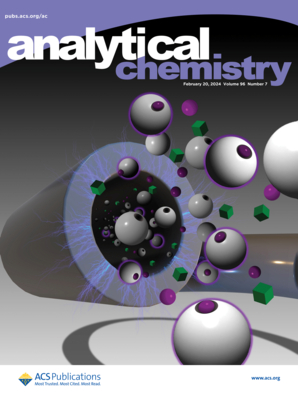CTLA4-Igs中α2,6和/或α2,3 Sialyl-Linkage异构体的纳米lc -四极轨-MS/MS鉴定
IF 6.7
1区 化学
Q1 CHEMISTRY, ANALYTICAL
引用次数: 0
摘要
细胞毒性t淋巴细胞相关抗原-4 (CTLA4)-Ig是一种用于治疗自身免疫性疾病的融合蛋白。在糖蛋白中,唾液酸通过α2,6或α2,3键与半乳糖相连,后者更为刚性,对于延长生物治疗药物的血清半衰期至关重要。然而,糖蛋白中α2,6和/或α2,3键的位点特异性鉴定仍然是一个重大的分析挑战。在这项研究中,我们对中国仓鼠卵巢(CHO)细胞中产生的CTLA4-Ig突变体(CTLA4-IgMT)进行了位点特异性n -聚糖分析。CTLA4-IgMT共过表达n -乙酰氨基葡萄糖转移酶iv和α2,6-唾液基转移酶。由于CHO细胞产生α2,3-连锁糖蛋白,因此以野生型CTLA4-Ig (CTLA4-IgWT)作为对照。在Pronase消化后,n -糖肽富集并使用纳米液相色谱-四极杆-轨道-串联质谱法进行分析。保留时间分析表明,α2,6链n -糖肽的疏水性低于α2,3链n -糖肽。断裂分析表明,α2,6键的断裂离子强度比([唾液酸]+/[n -乙酰氨基葡萄糖]+)较低。为了提高准确性,采用多元线性回归调整片段离子强度,得出n -乙酰氨基葡萄糖、半乳糖和唾液酸的补偿系数。利用这种方法,鉴定了CTLA4-IgMT的结构改变,包括6个额外生成的n -聚糖,11个部分转化的n -聚糖和6个完全转化的n -聚糖,总α2,6连锁比例为56.7%。值得注意的是,在CTLA4区的N76和N108位点发现了α2,6键,而在Fc区的N207位点则没有。本研究首次确定了CTLA4-Ig中三个n -糖基化位点的α2,6和/或α2,3键,为区分液氮键异构体提供了一种策略。本文章由计算机程序翻译,如有差异,请以英文原文为准。
Site-Specific Identification of α2,6 and/or α2,3 Sialyl-Linkage Isomers in CTLA4-Igs Using Nano-LC-Quadrupole-Orbitrap-MS/MS.
Cytotoxic T-lymphocyte-associated antigen-4 (CTLA4)-Ig is a fusion protein used to treat autoimmune diseases. In glycoproteins, sialic acids are linked to galactose via either α2,6 or α2,3 linkages, with the latter being more rigid and crucial for extending the serum half-life of biotherapeutics. However, site-specific identification of α2,6 and/or α2,3 linkages in glycoproteins remains a significant analytical challenge. In this study, we performed site-specific N-glycan analysis with sialyl-linkage isomers in a CTLA4-Ig mutant (CTLA4-IgMT) produced in Chinese hamster ovary (CHO) cells co-overexpressing N-acetylglucosaminyltransferase-IV and α2,6-sialyltransferase. Since CHO cells produce α2,3-linked glycoproteins, wild-type CTLA4-Ig (CTLA4-IgWT) was used as a control. Following Pronase digestion, N-glycopeptides were enriched and analyzed using nano-liquid chromatography-quadrupole-Orbitrap-tandem mass spectrometry. Retention time analysis revealed that α2,6-linked N-glycopeptides exhibit lower hydrophobicity than their α2,3-linked counterparts. Fragmentation analysis showed that fragment ion intensity ratios ([sialic acid]+/[N-acetylglucosamine]+) are lower for α2,6 linkages. To improve the accuracy, multiple linear regression was applied to adjust fragment ion intensities, deriving compensation coefficients for N-acetylglucosamine, galactose, and sialic acid. Using this approach, structural alterations in CTLA4-IgMT were identified, including 6 additionally generated, 11 partially converted, and 6 completely converted N-glycans, yielding an overall α2,6 linkage proportion of 56.7%. Notably, α2,6 linkages were identified at N76 and N108 in the CTLA4 region but were absent at N207 in the Fc region. This study is the first to determine α2,6 and/or α2,3 linkages at three N-glycosylation sites in CTLA4-Ig, providing a strategy for distinguishing sialyl-linkage isomers.
求助全文
通过发布文献求助,成功后即可免费获取论文全文。
去求助
来源期刊

Analytical Chemistry
化学-分析化学
CiteScore
12.10
自引率
12.20%
发文量
1949
审稿时长
1.4 months
期刊介绍:
Analytical Chemistry, a peer-reviewed research journal, focuses on disseminating new and original knowledge across all branches of analytical chemistry. Fundamental articles may explore general principles of chemical measurement science and need not directly address existing or potential analytical methodology. They can be entirely theoretical or report experimental results. Contributions may cover various phases of analytical operations, including sampling, bioanalysis, electrochemistry, mass spectrometry, microscale and nanoscale systems, environmental analysis, separations, spectroscopy, chemical reactions and selectivity, instrumentation, imaging, surface analysis, and data processing. Papers discussing known analytical methods should present a significant, original application of the method, a notable improvement, or results on an important analyte.
 求助内容:
求助内容: 应助结果提醒方式:
应助结果提醒方式:


